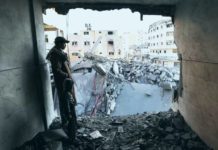Just two days after the ceasefire agreement went into effect, Trump was in Israel for his victory lap.
“We make the best weapons in the world, and we’ve given a lot to Israel frankly,” Trump declared triumphantly before the Israeli Knesset, prompting a standing ovation. “Bibi would call me so many times: Can you get me this weapon or that weapon? … But you used them well.”
Trump heaped praise on the Israeli Prime Minister and architect of the Gaza genocide. At one point, he diverted from planned remarks to call for a pardon of Netanyahu’s active corruption charges. “Hey, I have an idea… why don’t you give him a pardon? Cigars and some champagne — who the hell cares?”
The hero’s welcome Trump received in Israel drives home the complexity of this moment. It is undeniably true that the ceasefire brings immediate relief to Palestinians in Gaza. But it also likely marks the beginning of a new era, one in which Israeli apartheid and genocide are normalized and integrated into a regional and global economy.
In this Wire, we’ll break down the five most important takeaways from the ceasefire agreement.
1. The ceasefire agreement brings immediate relief to Palestinians who are struggling to survive unimaginable conditions.
The ceasefire officially went into effect last Friday. That doesn’t mean Israel isn’t killing Palestinians — but the large-scale bombardment and wholesale slaughter has ground to a halt.
Over the weekend, tens of thousands of Palestinians could be seen returning to the land where their homes once stood in Gaza’s north. Cooking oil crossed Gaza’s borders for the first time since March. On Sunday, the UN said it was making “real progress” getting life-saving aid delivered to Palestinians in Gaza. But this aid remains woefully inadequate, and Israeli leaders have already threatened to cut the number of aid trucks being allowed into Gaza if the return Israeli hostages proceeded too slowly.
On Monday, Hamas handed over the twenty surviving Israeli hostages. Israel released nearly 2,000 of the 11,000 Palestinian hostages set to be released throughout the course of the multi-phase ceasefire agreement.
We watched videos of hundreds of formerly detained Palestinians, mostly men, crowded into buses as they arrived back in Gaza. Held without charge or trial, many were abducted from their homes or during Israeli military raids on hospitals over the course of the last two years. There are cheers and screams of joy as they disembark, embracing their families through tears. For others, there is only grief, as they learn for the first time that their families did not survive the genocide.
2. The Israeli government has a track record of breaking ceasefire agreements, and it could still resume the bombardment at any moment.
Though mainstream Western media outlets reported that the ceasefire was “holding” as of Wednesday morning, the Israeli government has already violated the terms of the agreement, killing at least 9 Palestinians while they were attempting to return to their homes in north Gaza.
Outside of the context of the current agreement, we know that Israel unilaterally shattered the last ceasefire agreement in January, which ushered in arguably the most brutal stage of the genocide.
Even after Israeli troops withdraw from the front lines — stipulated during the first phase of the agreement — nearly 60% percent of Gaza will remain under Israeli control. It remains unclear how long it will take Israeli troops to completely withdraw from Gaza, and Israeli leaders have made no guarantee that they intend to do so. To make matters worse, the agreement allows Israel to maintain a presence in a buffer zone along Gaza’s border until there is no “resurgent terror threat,” which many believe could pave the way for Israel to maintain a presence in Gaza indefinitely.
3. Gaza has been completely devastated. Palestinians will feel the impacts of the genocide for decades to come.
The horror wreaked by the Israeli military in Gaza has forever altered the fabric of Palestinian society. At least 67,000 Palestinians have been killed, though the death toll is likely far higher. According to Israel’s own estimates, more than 10% of Gaza’s population were injured or killed in the last two years. They are months-old babies, middle schoolers, newlyweds and university students, parents and grandparents — each one of them an entire world whose light was snuffed out too soon.
The Israeli military killed at least 20,000 children in Gaza. Those who survived have endured incomprehensible trauma. As of December 2023, just three months into the genocide, more than 1,000 children in Gaza had lost one or both of their legs to the Israeli military’s relentless onslaught. Today, Gaza has the highest per capita number of child amputees of anywhere in the world. By February 2024, UNICEF estimated that at least 17,000 of Gaza’s children were now “unaccompanied” or separated from their parents. The sheer number of children made orphans by the Gaza genocide gave rise to a new acronym among medical workers: WCNSF — wounded child, no surviving family.
Half a million Palestinians in Gaza are currently trapped in Israel’s man-made famine, and even though more aid is flowing in now than before, the damage has been done: Untold numbers of Palestinians have died of starvation, mothers have given birth to malnourished babies, and children in the prime of their development have passed the point of no return, bringing irreversible, life-altering impacts. Beyond those who survived it, the effects of Israel’s famine will be felt for generations to come.
For the last two years, Israel has made Gaza “hell on earth,” intentionally and systematically targeting everything that makes life possible, from hospitals, homes, and schools to sewage systems, cropland, and water desalination plants.
Surveying the destruction:
- 94% of hospitals were damaged or completely destroyed as of May 2025; as of October 2025, less than half of Gaza’s hospitals were even partially functioning
- More than 80% of water and sanitation infrastructure had been destroyed by February 2025
- 92% of all residential buildings have been damaged or destroyed
- Only 1.5% of Gaza’s agricultural land remained undamaged and accessible as of August 2025, 90% cattle have died, and half of sheep and goat herds have been wiped out, decimating local food systems
The UN has estimated that it will cost $70 billion to rebuild Gaza, with the destruction now covering over 80% of the territory. Israel has made no commitment to end its 18-year brutal blockade on Gaza, and it’s unclear how major reconstruction efforts could begin without a new governing body in place. Even then, rebuilding will take years.
In the meantime, Palestinians are sifting through the debris to find missing loved ones and slowly returning to the ruins where their homes once stood, with many placing their makeshift tents atop the rubble.
4. This ceasefire agreement explicitly denies Palestinians the right to determine their own future and does nothing to hold Israel accountable for committing acts of genocide.
Trump’s deal being heralded today does nothing to address Israel’s brutal military rule and oppression of Palestinians. It does nothing to challenge Israeli impunity. It does nothing to hold perpetrators to account. It does nothing to prevent future atrocities.
As we said last week, the agreement also denies Palestinians the right to self-determination, laying out plans for a transitional government of Palestinian technocrats approved by Israel, which will be overseen by an international body that would include the likes of Trump and Tony Blair.
Israel is already making moves to sabotage future phases of the deal and the long-term fight for Palestinian freedom. In fact, after the deal was already made, Israel unilaterally removed Palestinian political prisoners who it believes would be best suited to lead the formation of a united Palestinian front from the list of those to be released.
Trump is correct that the ceasefire agreement will usher in a new age, though it’s unlikely to be a peaceful one. By brokering a deal that denies Palestinians the freedom to govern themselves and refusing to hold Israel to account for its violations of international law, the Trump administration makes future atrocities inevitable and formally cements a new world order in which Palestinian dispossession is normalized and international law has been so thoroughly undermined as to be rendered meaningless.
Though the bombardment has stopped, the long-standing Zionist campaign to erase Palestinians will continue, albeit at a slower pace: through the unrelenting theft of Palestinian land, and the killing and imprisonment of anyone who resists.
5. Our movement’s task is to ensure a permanent end to Israel’s genocide — what we have been demanding for the last two years — and to recommit ourselves to the long-term struggle for a free Palestine.
It’s been clear since the beginning of the genocide that even when a ceasefire was reached, our movement’s fight would be far from over.
The sense of relief in this moment is palpable, as Palestinians reunite with their imprisoned loved ones, return to their lands, and begin to rebuild. But this moment is also fraught with contradiction: Gaza’s future hangs in the balance, and Israel remains as determined as ever to erase Palestinians from Palestine, ceasefire deal or not.
Hundreds of thousands of us have been mobilizing for an end to the slaughter every day of the last two years. As we said last week, the world has risen up for — and been changed by — Palestine. New alliances across movements and organizing tactics have emerged in the process. And the right has taken notice, using the Palestine solidarity movement as testing grounds for its attacks on all of civil society.
Our task right now is to remain in escalated motion: to go bigger, bolder, and more defiant than ever before. We must bring the same strategic rigor, clarity of purpose, sense of resolve and everything we’ve learned over the last two years to the long term fight to end Israeli apartheid and occupation. Our movements cannot allow this moment to usher in a new era of total Israeli impunity, wherein genocide — the crime of crimes — is treated as the new normal.
We remind our readers that publication of articles on our site does not mean that we agree with what is written. Our policy is to publish anything which we consider of interest, so as to assist our readers in forming their opinions. Sometimes we even publish articles with which we totally disagree, since we believe it is important for our readers to be informed on as wide a spectrum of views as possible.











